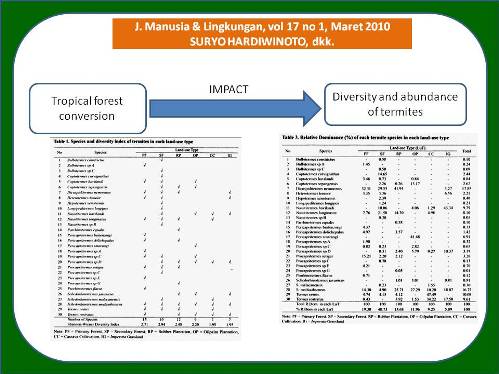
IMPACT OF TROPICAL RAIN FOREST CONVERSION ON THE DIVERSITY AND ABUNDANCE OF TERMITES IN JAMBI PROVINCE (Dampak Konversi Hutan Tropika Basah Terhadap Keragaman Jenis dan Kelimpahan Rayap di Provinsi Jambi)
Suryo Hardiwinoto(1*), Sri P Rahayu(2), Widyatno Widyatno(3), Haryono Supriyo(4), FX Susilo(5)
(1) Faculty of Forestry, Universitas Gadjah Mada, Yogyakarta, Indonesia
(2) Faculty of Forestry, Universitas Lancang Kuning, Pekanbaru, Riau, Indonesia
(3) Faculty of Forestry, Universitas Gadjah Mada, Yogyakarta, Indonesia
(4) Faculty of Forestry, Universitas Lancang Kuning, Pekanbaru, Riau, Indonesia
(5) Faculty of Agriculture, Universitas Lampung, Bandar Lampung, Indonesia
(*) Corresponding Author
Abstract
ABSTRACT
The degradation of tropical rain forest might exert impacts on biodiversity loss and affect the function and stability of the ecosystems. The objective of this study was to clarify the impacts of tropical rain forests conversion into other land-uses on the diversity and abundance of termites in Jambi, Sumatera. Six land use types used in this study were primary forest, secondary forest, rubber plantation, oil-palm plantation, cassava cultivation and Imperata grassland. The result showed that a total of 30 termite species were found in the six land use types, with highest species richness and abundance in the forests. The species richness and the relative abundance of termites decreased significantly when the tropical rain forests were converted to rubber plantation and oil-palm plantation. The loss of species richness was much greater when the forests were changed to cassava cultivation and Imperata grassland, while their abundance greatly decreased when the forests were degraded to Imperata grassland. Termite species which had high relative abundances in primary and secondary forests were Dicuspiditermes nemorosus, Schedorhinotermes medioobscurus, Nasutitermes longinasus and Procapritermes setiger.
ABSTRAK
Kerusakan hutan tropika basah dapat menimbulkan dampak lingkungan berupa penurunan keanekaragaman hayati serta terganggunya fungsi dan stabilitas ekosistem. Tujuan dari penelitian ini adalah untuk mengetahui dampak konversi hutan tropika basah menjadi bentuk penggunaan lahan lain di Jambi Sumatra terhadap keragaman jenis dan kelimpahan rayap. Enam tipe penggunaan lahan yang digunakan dalam penelitian ini adalah hutan primer, hutan sekunder, tanaman karet, tanaman kelapa sawit, kebun ketela pohon dan padang alang-alang. Hasil penelitian menunjukkan bahwa ditemukan 30 jenis rayap pada 6 tipe penggunaan lahan tersebut, dengan keragaman jenis dan kelimpahan individu rayap tertinggi pada lahan hutan. Kekayaan jenis dan kelimpahan relatif rayap menurun secara nyata apabila ekosistem hutan dikonversi menjadi tanaman karet dan kelapa sawit. Penurunan kekayaan jenis menjadi jauh lebih besar ketika hutan dikonversi menjadi kebun ketela pohon dan padang alang-alang. Kelimpahan individu rayap akan sangat menurun apabila terjadi perubahan ekosistem hutan menjadi padang alang-alang. Jenis-jenis rayap yang mempunyai kelimpahan tinggi pada ekosistem hutan adalah Dicuspiditermes nemorosus, Schedorhinotermes medioobscurus, Nasutitermes langinasus dan Procapritermes stiger.
Full Text:
ARTIKEL LENGKAP (PDF) (Bahasa Indonesia)Article Metrics
Refbacks
- There are currently no refbacks.
Copyright (c) 2017 Jurnal Manusia dan Lingkungan







